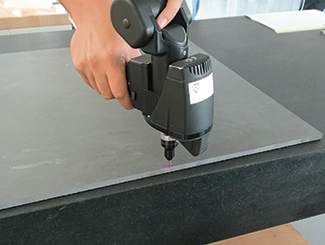 various authors (*)18
Settembre
2017
various authors (*)18
Settembre
2017
New tools for measuring ceramic tiles and slabs
The technological change that has brought to the development of large ceramic slabs has its roots into important changes in production and plant engineering; yet the existing legislation for the certification of the finished product hasn't been revised. National and international legislation still mainly refer today to tests which are more suitable for tiles of traditional size.
A good example is EN ISO 10545-2: “Determination of dimensions and surface quality”.
Determining the dimensions of large format tiles requires measuring systems which differ from traditional ones but that are as reliable. The horizontal data-plucometro (Fig.1), for example, can't be used for tiles over 60x60 cm. Moreover, large slabs can bend under their own weight as much as the calibration tiles used as a reference for the test, therefore invalidating final results. Finally, the inconvenience of handling large products during tests contributes to making the process a difficult one.
To face these urgent issues the Ceramic Centre is considering alternative measuring systems, which have been in place for many years in advanced mechanics. Research is one of the tasks of the regional project “Process innovation for the sustainable tile chain” [IPERCER], financed by the Emilia Romagna Region via POR-FESR 2014-2020 funds, Priority Axis 1 Research and Innovation, Action 1.2.2.
In particular, the focus is on using a coordinate measuring machine (CMM) (Fig.2), and a portable 3D measuring arm (Fig.3). A series of experimental measures have been taken on three lots of tiles measuring 20x20, 40x40 and 60x60 cm so as to compare the results obtained by means of the horizontal data-plucometro with the two above-mentioned systems. All dimensions (length, width, straightness of sides, rectangularity, surface flatness, centre curvature, edge curvature, warpage) have been measured according to the procedure as described in the regulation (Tab.1). Furthermore, in order to compare the three techniques and exclude all possible irregularities in the tested samples, the same measurements have been taken on a 30x30 cm calibration tile (Tab.2).
In order to comply with EN ISO 10545-2, the portable measuring arm and CMM have had their methods of measurement and software calibrated and tuned.
For each dimension (size, straightness of sides, rectangularity, etc.) a system of alignment and geometrical elements has been set up so as to virtually recreate the material conditions that occur when measuring with the data-plucometro.
Results achieved to date have shown perfect agreement between the three techniques (Tab.1). The comparison between the dimensions, measured according to the procedure established by EN ISO 10545-2, highlights discrepancies no greater than a few tenths of a point, showing the possibility to measure dimensions of tiles according to legislation in force both with the portable 3D measuring arm and the CMM machine.
The research also marked out a few limits in the current legislation for the determination of dimensions, in particular the representativeness of the points selected during the test to describe the geometrical characteristics of the product. The EN ISO 10545-2 regulation provides that only 21 points be considered on the tiles (9 on surface and 12 on the sides, Fig.4); but this number may not be sufficient to identify possible flaws, especially in large ceramic slabs.
The activity carried out has highlighted the main differences between the data-plucometro and the other two technologies: CMM and portable measuring arm. Such differences (see below) can in some cases be read as strong points of a technology against the other:
• with the data-plucometro measurements are carried out through comparison with a calibration tile: it is therefore an indirect measuring system. The CMM and portable measuring arm, on the other hand, do all the measurements by aligning a theoretical level calculated by measuring three points on the tile; this is therefore a direct measuring system;
• the data-plucometro needs to have the tile put upside down based on a three point level, while with the CMM and portable measuring arm the tile is set against a flat board having an appropriate surface finish. In both cases measurements are done on the tile surface. But, while the tile is rotated 4 times when measured with the plucometro, with the CMM and measuring arm once the tile is set it is not moved until the test is over;
• the data-plucometro is able to take reliable measurements (in particular as to surface flatness) for tiles up to 60x60 cm, while the CMM and portable measuring arm can measure larger tiles, up to the sizes currently in use;
• measuring with the data-plucometro is rather simple, while the CMM technology and the measuring arm require a certain level of ability and experience from the operator. Moreover, the current software programmes provided need to be constantly modified and integrated, as the measuring system is not automatic.
Another thing to consider is that the measuring arm is easy to carry. If the surface to be measured has an appropriate surface flatness, measurements can be taken by a specialised technician also on set, therefore avoiding the movement and handling of large format tiles, and speeding up analysis. But analysis are carried out quickly with CMM as well, thanks to a high level of automation.
To date CMM systems cost around 100,000 €, while portable measuring arms are about 50,000 €, software included. But these, if equipped with a specific software programme for the ceramic industry which would be semplified compared to the software they're currently sold with, are likely to be traded in the short term at a much lower price.
(*) Sandra Fazio, Leonardo Sanseverino, Maria Chiara Bignozzi – Ceramic Centre
Pierpaolo Carrino, Giuseppe Carboni - Reverse&Quality